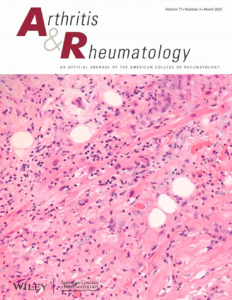 Arthritis & Rheumatology (A&R) is the flagship journal of the ACR, with articles covering common and rare rheumatic diseases, as well as clinical and translational aspects of rheumatic disease science. The current editor in chief of A&R, Daniel H. Solomon, MD, MPH, is a professor of rheumatology at Harvard Medical School, Boston, and holds the Matthew H. Liang Distinguished Chair in Arthritis and Population Health in Rheumatology at Brigham and Women’s Hospital, Boston.
Arthritis & Rheumatology (A&R) is the flagship journal of the ACR, with articles covering common and rare rheumatic diseases, as well as clinical and translational aspects of rheumatic disease science. The current editor in chief of A&R, Daniel H. Solomon, MD, MPH, is a professor of rheumatology at Harvard Medical School, Boston, and holds the Matthew H. Liang Distinguished Chair in Arthritis and Population Health in Rheumatology at Brigham and Women’s Hospital, Boston.
Dr. Solomon has spent some 15 years working as co-editor, deputy editor and—since 2020—editor in chief of A&R. This summer, he will pass the reins to S. Louis Bridges Jr., MD, PhD, physician in chief and chair of the Department of Medicine, and the Franchellie M. Cadwell Professor of Medicine at the Hospital for Special Surgery (HSS), New York. Dr. Bridges is also chief of the Division of Rheumatology at both HSS and Weill Cornell Medical College.
As Dr. Solomon begins to wrap up his years of service with A&R, The Rheumatologist (TR) asked him to discuss some of the journal’s new features and directions, his approach to ensuring readers have access to peer-reviewed, salient articles that advance the science and practice of rheumatology, and his thoughts about A&R’s future.
TR: To start off, how would you describe A&R and its value?
Dr. Solomon: A&R really tries to represent all rheumatologic practice and rheumatologic research. So we don’t just publish articles on the top diseases, such as rheumatoid arthritis (RA), psoriatic arthritis, lupus and osteoarthritis, but also on rare diseases (e.g., scleroderma) and less rare diseases (e.g., juvenile idiopathic arthritis).
In the past five years, we’ve covered 40–50 different rheumatic diseases, with about 50% of our articles on clinical science, including trials and epidemiology, and about 50% on translational science.
TR: Would you expand a bit on the translational articles the journal includes?
Dr. Solomon: The translational work underpins the science of rheumatology, so it is critical that rheumatologists understand these scientific trends. In this way, the journal helps inform research, as well as clinical practice.
When considering a manuscript, I always ask whether an article has a potential role in impacting clinical practice. That means making sure our articles are not too far away from the clinic in time or space. This [approach] ensures our clinical readership will say, ‘Oh, that’s really interesting, I wonder how that’s going to play out,’ and the researchers who read the journal will say, ‘Oh, that’s really important for what I’m doing today.’




